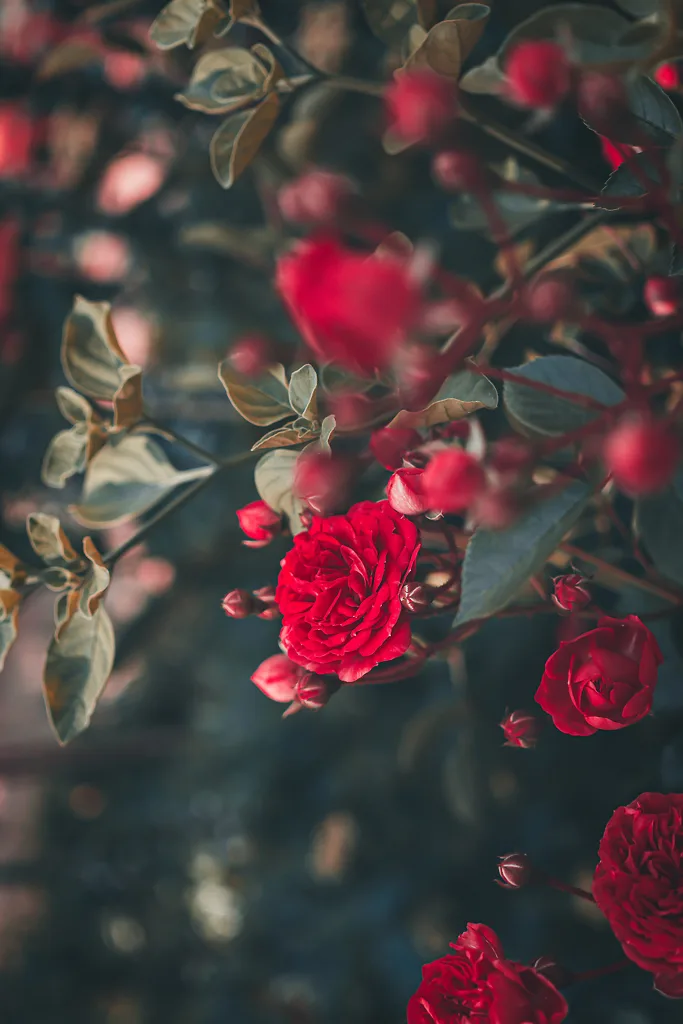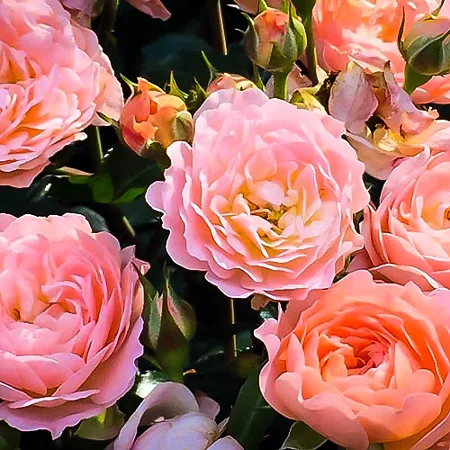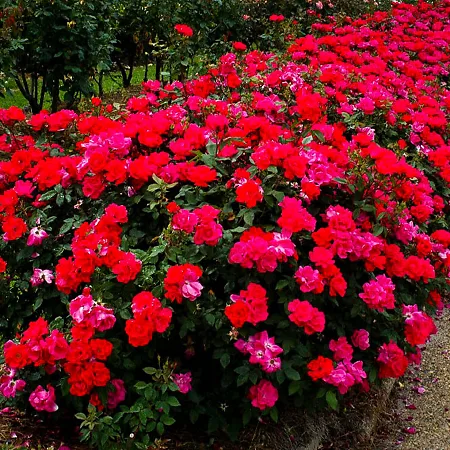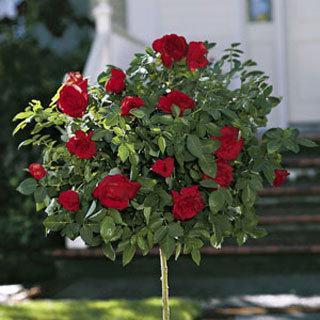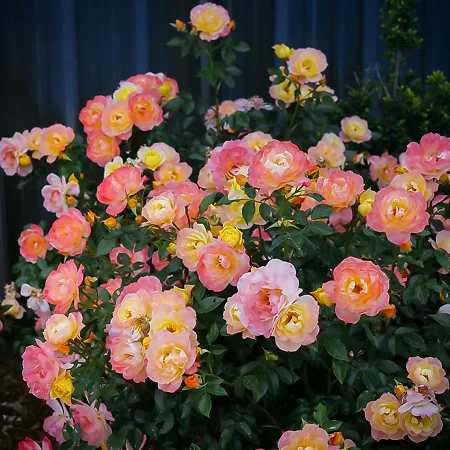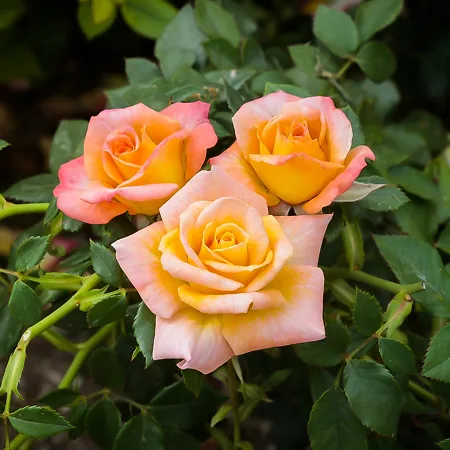Rose Bushes
The rose needs no introduction. A staple of the garden for generations, there are over 100 unique species of rose in the genus Rosa. Beyond the species, thousands of individual cultivars have been developed, primarily as a means of capturing color and growth mechanisms. Although the red Rose is the most famous, red, pink, and yellow roses are all available for planting in the United States. There are two stand-out groups of roses most commonly planted: Knockout Rose Bushes or Trees and Rose Trees. Rose Bushes are planted for a variety of reasons. As ornamental plants, there are few comparisons. The fragrant, showy blooms of the Rose Bush appear in summer. Rose petals can be distilled to create Rose Oil or Rose Tea, which is used in cooking, make-up, and tea.
The most important aspect of caring for a Rose Bush is careful forethought. Rose Bushes have specific requirements. Roses prefer neutral, loamy soils within full view of the sun. Different Rose Bushes are often planted within close proximity to one another to create a Rose Garden.
How to Buy Rose Bushes
Buying Rose Bushes requires adequate research. Rose Bushes have specific requirements with regards to sunlight exposure and watering needs that will impact the growth of the Rose Bush upon successful planting. Once the Rose Bush has been determined as best suiting the needs of the landscaper, and the Rose Bush’s needs have been taken into account, it is important to choose a reputable arborist from which to buy the Rose Bush. The Tree Center ensures proper care during the initial stages of development, so that with proper planting the Rose Bush will awe its viewer with spectacular blooms if planted and cared for properly.
How to Plant Rose Bushes
Sun: Plant in full sun with at least 5 to 6 hours of full sun during the day.
Water: Water immediately after planting and twice a week for the entirety of the Rose Bushes lifespan. On average, Rose Bushes require over 90 inches of rain annually.
When to Plant: Plant in early to mid-spring.
It is best to research the Rose Bush carefully before planting. Rose Bushes require full sun exposure for between 5 and 6 hours a day, as well as adequate watering. If the Rose Bush suits the anticipated planting area, simply order a young sapling from The Tree Center for spring planting.
Once the bush sapling arrives, inspect the root ball. This is the collection of roots at the base of the shrub. The root ball will indicate the size of the hole to be dug. To dig the hole, dig a hole three times the width of the root ball. Width is essential, as the roots of the Rose Bush will extend outward, laterally along the ground. Many first-time planters dig holes too deep, which encourages the Rose Bush to grow downward. This is not idea, for if the roots extend too far downward, water and air will experience difficulty in reaching the Rose Bush’s root system. The hole should actually be an inch or two shorter than the height of the root ball, which will allow for the bush to settle over time.
Stand the sapling vertically in the hole while backfilling it with soil and water. If using mulch, which is recommended with Rose Bushes, mulch now before watering immediately.
Soil Type
The soil surrounding the Rose Bush will be essential in its eventual success. Soil is made categorized in a variety of ways. The first way is be soil type. This refers to the size of the soil grains. Clay and silt soils are made up of tiny sized particles. Oftentimes, these particles will stick together with the addition of water, creating impenetrable walls through which water and air cannot move. This is not beneficial to the Rose Bush, which needs easy access to both air and water to survive. Likewise, sandy soils, which are composed of large particles, do not work. This is because the large grains filter air and water too quickly, not allowing time for the Rose Bush to absorb its needs. The best soil for Rose Bushes, and most plants, is loam. Loam is a combination of differently sized particles which, when working together, enable a steady movement of water and air. This impacts drainage.
Soil can also be categorized by its pH, macronutrient properties, and micronutrient properties. Although Rose Bushes are tolerant of changes in the nutrient matter of the soil, they prefer soil that is neutral with regard to pH; specifically, Rose Bushes prefer a pH of 6.5. The pH of the soil is best identified through an at-home pH kit or through the services of a local landscaper or pedologist.
Drainage is essential. Rose Bushes, although they love water, do not like to bathe in it. Avoid poorly-drained soils. Encourage drainage by composting the planting location prior to planting, or using a container or raised bed for gardening.
Water Access
Rose Bushes require moderate to heavy watering. Unlike many flowering plants, which once established may exhibit drought-tolerant behaviors, most Roses require continued maintenance after planting. It is best to heavily water the three foot radius surrounding the Rose Bush at least twice a week, especially during dry summer months. Furthermore, Rose Bushes prefer regular heavy waterings as opposed to overly frequent light waterings. Rose Bushes require, on average, 90 inches of rainfall annually.
Mulch and Fertilizer
Mulches and fertilizers are tools in the planter’s toolbox. Mulch is essential when planting and growing Rose Bushes. Mulch does many things to benefit the Rose Bush. First, it increases the surface area surrounding the bush. This will help to hold water and air for the roots when the soil has become unsaturated. Next, mulch helps to conserve water. The mulch will keep water from becoming run-off, both increasing the environmental effectiveness of the planting and reducing water costs to the landowner. This also makes the water delivery process more efficient. Apply a 3 inch layer in a 3 foot radius around the Rose Bush. This will encourage healthy growth.
Fertilizer, on the other hand, is not always needed. However, Rose Bushes can benefit from regular fertilizations, which will not only increase the content of the soil, but also increase worthy blooms. Simply apply a balanced, low-nitrogen fertilizer (e.g. 5-10-10) once a month between April and June. Some gardeners also suggest sprinkling Epsom salts into the fertilizer to increase growth.
More Information on Rose Bushes
There are over 100 species of the symbolic Rose Bush, and the thousands of individual cultivars provide distinct coloring, growth mechanisms, and unique benefit. Not only is the Rose Bush beautiful, but it is also fragrant. Roses are also known for their habit of forming sharp prickles on their branches. These are not, technically, thorns, which are themselves extensions of the stem. Prickles are extensions of the plant epidermis. These will cause pain to most creatures, including humans, who would seek to infiltrate the plant’s flower; however, deer often are seen grazing the flowers of Rose Bushes, and the prickles seem to have little effect on them.
Rose Bush Varieties and Cultivars
There are thousands of cultivars of the Rose Bush; most notably, Knockout Roses and Rose Trees are unique in their ranges of growth and physical appearance. Most Rose Bushes are grown because they are beautiful; for some, they pose a gardening challenge, though many known that a rose will thrive upon being neglected, so long as the location is of a high caliber. Consider the following types of Rose Bush before planting in a given location.
Knockout Rose Varieties
Knockout Rose Bushes are so-named for their vibrant colors, large blooms, and easy maintenance. Most Knockout Rose varieties grow between 3 and 5 feet tall on a sturdy stem. These cultivars prefer USDA Hardiness Zones 5 through 10. Pinks, reds, and yellows are in store for the savvy gardener who chooses to explore the options opened by the Knockout Rose. In addition to aesthetic appeal, Knockout Rose Bushes are easy to maintain and colorful, thus their “knockout” effect.
Rose Tree Varieties
Rose Trees consist of a smaller selection of Rose Bushes, these reaching between 3 and 4 feet in height. Hardy in USDA Hardiness Zones 5 through 10, Rose Tree varieties include the stunning Sunny Rose Tree, which is itself a Knockout cultivar. Buttery-yellow blooms accompany this tree, which displays with easy care.
Benefits of Rose Bushes
Rose Bushes provide an entirely unique display of color to the gardener willing to put in the initial effort. A garden full of these diverse blooms is sure to delight, both in fragrance and in color. Rose Bushes are surprisingly easy to care for and grow. Additionally, many can be grown both in the garden and in the pot.
Rose Bush Concerns
Rose Bushes are easy to grow, so long as proper care is provided. Once the soil and sun exposure are considered during the initial planting planning, watering is the main final concern. Provide adequate watering and the Rose Bush will continue to delight for several years. Despite this, there are a number of pests and diseases that may affect the growth of the Rose Bush. Blackspot, Powdery Mildew, Stem Cankers, Botrytis Blight, Mosaic, Crown Gall, Rose Rosette, Aphids, Leaf Cutter Bees, Spider Mites, Thrips, and numerous other pests may invade the Rose Bush, Inspect the plant for signs of fungal or pest affectation in the leaf or root.
